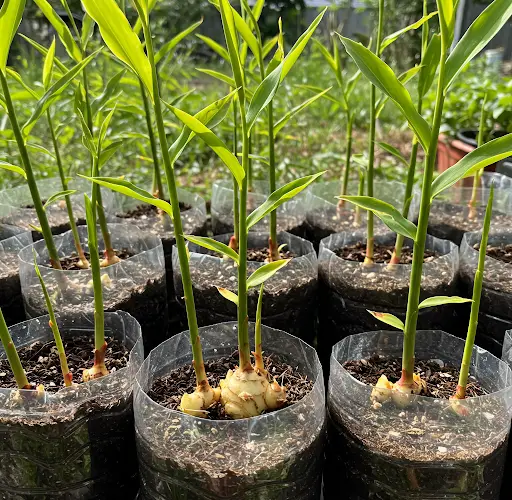How to Grow Ginger in Water for Beginners – A Simple Guide to Growing Ginger at Home
Ginger is a versatile and widely used spice known for its medicinal and culinary benefits. It is commonly grown in soil, but did you know that you can also grow ginger in water? This method is ideal for beginners, requires minimal effort, and can be done indoors, making it perfect for those with limited space. In this guide, we will walk you through the step-by-step process of growing ginger in water, ensuring a continuous supply of fresh ginger right from your home.
Why Grow Ginger in Water?
Growing ginger hydroponically (in water) comes with several advantages:
- No Messy Soil: You don’t need garden soil or pots, making it a clean and space-saving method.
- Easy Maintenance: No need to worry about overwatering or soil quality.
- Year-Round Growth: Ginger can be grown indoors regardless of the season.
- Sustainable & Eco-Friendly: It’s an efficient way to grow food without depleting soil nutrients.
Materials Needed
To successfully grow ginger in water, you will need:
- A fresh ginger root (preferably organic and with visible growth buds or “eyes”)
- A wide-mouthed glass jar or container
- Clean, non-chlorinated water (filtered or distilled is best)
- Toothpicks or skewers (optional, for suspending the ginger in water)
- A warm, well-lit location (but not direct sunlight)
- Liquid fertilizer (optional, for added nutrients)
Step-by-Step Guide to Growing Ginger in Water
Step 1: Choose the Right Ginger Root
- Select a plump, fresh ginger root with several “eyes” or growth buds.
- Avoid shriveled or overly dry roots, as they may not sprout well.
- If the ginger has been refrigerated, let it sit at room temperature for a few days before using.
Step 2: Prepare the Ginger Root
- Rinse the ginger thoroughly to remove any dirt or chemicals.
- If the ginger root is large, cut it into smaller pieces, ensuring that each piece has at least one or two growth buds.
- Soak the ginger in warm water overnight to encourage sprouting.
Step 3: Set Up the Water Growing System
There are two common methods to grow ginger in water:
Method 1: Floating in Water with Toothpicks
- Insert three or four toothpicks around the middle of the ginger piece.
- Suspend the ginger in a jar of water so that the bottom half is submerged while the top remains dry.
- This method ensures proper oxygen exposure, preventing rot.
Method 2: Fully Submerged in a Shallow Container
- Place the ginger root flat in a shallow container with just enough water to cover the bottom.
- Change the water every 2-3 days to prevent bacterial growth.
- This method is simpler and works well for beginners.
Step 4: Provide Optimal Growing Conditions
- Temperature: Keep the ginger in a warm environment (70-80°F or 21-27°C) for optimal growth.
- Light: Place the container in indirect sunlight or a bright indoor location. Too much direct sunlight can cause the root to dry out.
- Water Quality: Always use clean, filtered water to prevent chlorine damage.
- Change Water Regularly: Refresh the water every 2-3 days to avoid stagnation and prevent mold.
Step 5: Encourage Sprouting and Growth
- After 1-2 weeks, small shoots and roots should begin to appear.
- Once the shoots grow to about 2 inches, consider transferring the ginger to a hydroponic system or continuing to grow it in water.
- If you want faster growth, you can add a diluted liquid fertilizer every two weeks.
Step 6: Harvesting Your Ginger
- Ginger grown in water can take several months to develop substantial rhizomes.
- Once the plant has grown a few leaves and the roots are well-developed, you can begin harvesting small portions.
- To harvest, simply cut a small piece from the root and allow the rest to continue growing.
Tips for Successfully Growing Ginger in Water
- Start with Healthy Ginger: Organic ginger without chemical treatments will sprout more easily.
- Avoid Stagnant Water: Regularly changing the water prevents bacterial growth and keeps the ginger healthy.
- Provide Warmth and Humidity: Ginger thrives in a warm, humid environment, similar to its natural tropical habitat.
- Be Patient: Ginger grows slowly, so don’t be discouraged if you don’t see immediate results.
Common Problems and Solutions
| Problem | Cause | Solution |
|---|---|---|
| Ginger isn’t sprouting | Too cold or not enough humidity | Move to a warmer area and mist occasionally |
| Water is turning slimy | Stagnant water or bacteria growth | Change water regularly and clean the container |
| Root is rotting | Too much water exposure | Use the toothpick suspension method or reduce water level |
| Leaves turning yellow | Lack of nutrients or excessive sunlight | Use diluted fertilizer and move to indirect light |
Can You Transplant Ginger from Water to Soil?
Yes! If you decide to transition your ginger from water to soil for larger yields, follow these steps:
- Prepare a pot with well-draining soil rich in organic matter.
- Gently plant the sprouted ginger root, covering it lightly with soil.
- Keep the soil moist and place the pot in a warm, humid location.
- Continue regular watering and feeding until the plant matures.
Conclusion
Growing ginger in water is an easy and rewarding way to cultivate this beneficial plant at home. Whether you want to keep it as an indoor plant or eventually transplant it into soil, this method ensures fresh ginger availability all year round. With minimal effort, you can enjoy homegrown ginger for cooking, teas, and health remedies without needing a garden. Start growing your own ginger today and experience the joy of harvesting from your own home!



